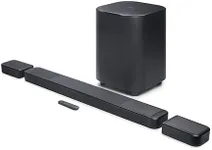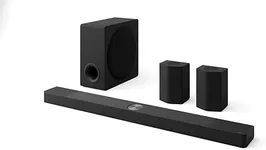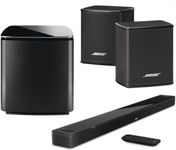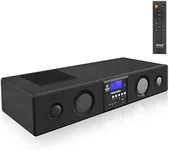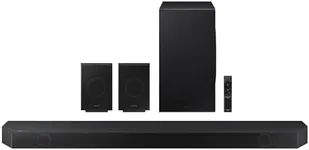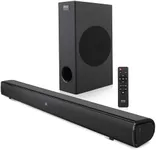Buying Guide for the Best Soundbars
Choosing a soundbar can greatly enhance your TV or home entertainment experience. A soundbar is a simple way to get better sound quality without the hassle of setting up a full speaker system. The goal is to pick a soundbar that’s easy to set up, matches the size of your room and TV, and offers the audio features you’ll actually use. Start by thinking about what you mainly watch or listen to (like movies, sports, or music), what types of devices you want to connect, and how important things like bass or voice clarity are to you. Understanding the main features will help you make a choice that fits your space and your listening preferences.ChannelsChannels in a soundbar refer to the number of separate audio outputs or speakers built into the unit, often described as numbers like 2.0, 2.1, 3.1, or 5.1. The first digit is the number of speakers, and the second shows if it has a subwoofer. More channels mean a fuller, more immersive sound, and some high numbers support surround sound formats. For typical TV watching in a small room, a 2.0 or 2.1 soundbar is often enough, while movie lovers or those with larger rooms may benefit from 3.1 or even 5.1 models with rear speakers. Choose based on the size of your room and how important surround sound is to your experience.
Subwoofer PresenceA subwoofer handles the deep, low sounds (bass) that add punch to music, action movies, and games. Some soundbars come with a built-in or separate subwoofer, while others don’t. Having a subwoofer is important if you want rich, powerful bass, especially for movies and music with lots of depth. If you mostly watch news or sitcoms, a soundbar without a subwoofer might be fine, but for a more cinematic or bass-heavy experience, look for one with a dedicated subwoofer.
ConnectivityConnectivity refers to how the soundbar connects to your TV and other devices, such as HDMI (including ARC/eARC), optical, Bluetooth, or Wi-Fi. HDMI connections (especially with ARC or eARC) provide the highest sound quality and allow your soundbar to work smoothly with TV remotes. Bluetooth and Wi-Fi are handy for streaming music from your phone or computer. Pick a soundbar with the connection options that match your TV and any other devices you plan to use, ensuring setup will be simple and future-proof.
Size and PlacementThe size of a soundbar relates to its length and height, which should match or complement your TV and fit comfortably in your room, either on a TV stand or mounted on a wall. Too small, and it might not deliver enough volume or presence; too large, and it could look awkward or block your TV’s remote sensors. Measure the space where you plan to put the soundbar and choose one that fits both physically and visually.
Sound Modes and EnhancementsSound modes and enhancements are built-in settings that adjust the audio for different situations, like movies, news, sports, or music. Some soundbars offer special features like voice enhancement for clearer dialogue, night mode for softer sound at night, or virtual surround sound to mimic a multi-speaker setup. Think about what you’ll use most often—a movie fan might want surround sound and voice clarity, while a music listener might prefer a rich music mode.
Smart FeaturesSmart features include things like built-in voice assistants (such as Alexa or Google Assistant), app control, or integration with smart home systems. These features let you control your soundbar with your voice or phone, play music directly from streaming services, or sync with other smart devices. Consider whether convenience is important to you, and if you already use a specific voice assistant or smart home platform, look for a soundbar that’s compatible.




